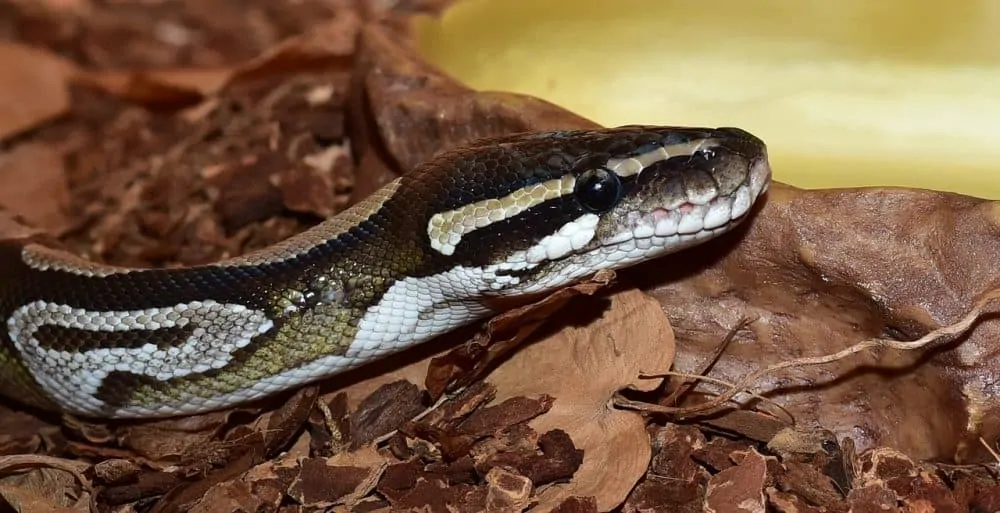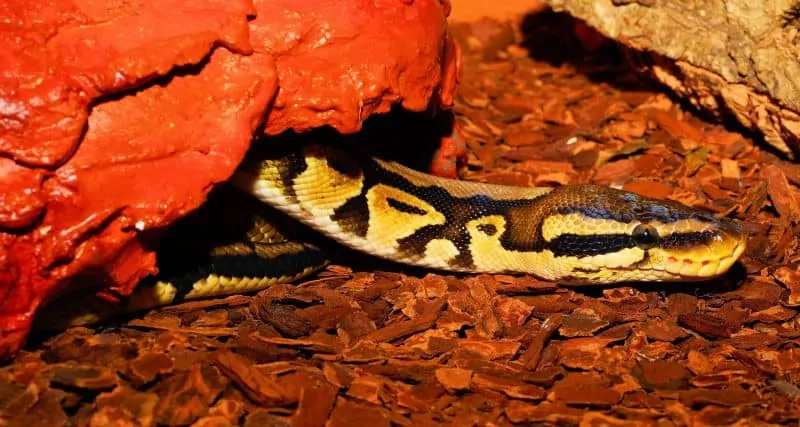I’d had this particular ball python for nearly six months, and he’d yet to eat voluntarily. These days, given that most ball pythons on the market are captive bred, prolonged fasts aren’t particularly common. But back in the mid-90s, wild-caught individuals – who’re notorious for refusing food for months or longer – outnumbered captive-bred specimens.
I’d tried every type of rodent and every type of presentation imaginable, without success. As a last-ditch attempt, I changed up his substrate, switching out his paper towels for some fresh cypress mulch. After giving him a few days to adjust, I offered him a pre-killed mouse, which he (thankfully) struck, wrapped and consumed.
Switching your snake’s substrate isn’t usually an effective way to induce feeding. However, it worked in this case, and it illustrates a larger point: Your choice of substrate is an important consideration for your ball python, and it may affect several different aspects of his life.
Substrate selection is a relatively contentious subject among snake keepers – including ball python enthusiasts. Many keepers have strong feelings about the subject and tend to view their preferred choice as the only option.
But this is certainly not the case. Different substrates work best in different situations, for different keepers, and with different individual animals. So, it is important to learn all you can about the various options available, and then make the best choice you can.
We’ll try to help you pick the best one for your pet below.
Good and Bad Substrates
There are a wide variety of substrate options available to ball python keepers, but some are much better choices than others. Some may even be dangerous for your pet. We’ve tried to list some of the most common choices below, split into two categories: those that are good choices for ball pythons, and those that are not.
Good Ball Pythons Substrates
- Newspaper
- Paper towels
- Commercial paper cage liners
- Recycled paper beddings
- Cypress mulch
- Orchid bark
- Bioactive substrates
- Aspen shavings
Bad Ball Python Substrates
- Sand
- Cedar shavings
- Astroturf
- Gravel
Note that some keepers may have some success with Astroturf or gravel, but these substrates are generally not a good choice for beginning keepers.
Safe Substrates for Ball Pythons
Your snake’s substrate has important safety implications – some are relatively safe and unlikely to cause problems, while others are more likely to cause infections, illness or intestinal blockages.
We’ve listed some of the safest substrate choices below:
Newspaper
Newspaper is the substrate of choice for most professional breeders. It’s easy to see why: Newspaper is not only free, it is also hygienic, unlikely to cause intestinal obstructions, and it makes cage maintenance very easy.
Paper towels
Paper towels offer many of the same benefits that newspaper does, and they are often more absorbent too. The only downside to paper towels (aside from their relatively poor aesthetic value) is that they are more expensive than newspaper.
Commercial paper cage liners
Commercial cage liners are a great choice for keepers with large enclosures. They are more expensive than newspaper or paper towels, but they are often easier to use, and they often look better too.
Recycled paper beddings
Recycled paper beddings are a good option for keepers who want a hygienic substrate (like newspaper) yet want their snake to have the chance to burrow. They’re much more expensive than plain newspaper and do represent an ingestion hazard, but they’re the preferred choice of some keepers.
Cypress mulch
Cypress mulch is probably the safest particulate substrate you can use with a ball python. It is very absorbent, it holds moisture well, and it looks quite nice. It is just important to prevent your snake from accidentally ingesting any while he’s eating.
Orchid bark
Orchid bark is also a pretty safe substrate for ball pythons. It has many of the same benefits that cypress mulch does, but it is often a more expensive choice. Also like cypress mulch, you’ll need to use care when feeding your pet to prevent him from accidentally swallowing any bark pieces.
Bioactive substrates
Bioactive substrates are typically comprised of soil, coconut husk, or similar materials, as well as a variety of microorganisms to help facilitate the breakdown of wastes. Bioactive substrates are a lot of work, and they’re not easy for beginners to fine-tune. However, they can be used by keepers with sufficient desire and resources.
Aspen shavings
Aspen shavings are not ideal for ball python maintenance, as they will rot relatively quickly if they become wet. They also represent an ingestion hazard. However, aspen can be an acceptable choice, and some of the most successful ball python keepers in the world prefer it.
Ball Python Beddings to Avoid
While there are some ball python keepers who successfully use the following substrates, they present an elevated risk for your pet and are generally best avoided by beginners.
- Sand – While it is theoretically possible to use sand as a ball python substrate, it is generally not advisable to do so. Sand works better in low-humidity habitats, and it can also cause intestinal obstructions if swallowed in large quantities.
- Cedar shavings – Cedar shavings must never be used for any snake as they emit toxic fumes. Accordingly, it is important to carefully scrutinize any hardwood shavings you intend to use and ensure no cedar is present.
- Astroturf – Astroturf was a popular substrate in the past, but it is generally best avoided. Astroturf is hard to clean adequately, and loose fibers may lead to injuries or intestinal obstructions.
- Gravel – Gravel is heavy, difficult to work with, and it is very difficult to clean properly. It also presents a serious hazard to any snake who accidentally ingests some.
Bedding Maintenance
No matter which substrate you choose, you must be sure to keep it clean. Failure to do so may expose your snake to infection or other illness.
Generally speaking, you’ll need to address your snake’s substrate at least once each week. However, the type of substrate you choose will influence the way you go about doing so. For example, you’ll need to completely replace sheet-style substrates, such as paper towels or newspaper, while you can spot-clean mulch or other particulate substrates.
In either case, you’ll want to replace the substrate or spot-clean it anytime it becomes contaminated with feces, urates, shed skin or excessive quantities of spilled water. Additionally, you’ll want to completely remove and replace particulate substrates about once per month or so.
It’s your turn!
As you can see, there are a number of substrate options available to ball python keepers. They all offer different benefits and drawbacks, so just be sure to consider your choice carefully.
We hope you’ve found this article helpful, as you try to decide which substrate to give your ball python. If you’ve found this article helpful, please share it with your friends, and don’t hesitate to share your thoughts or questions in the comments below.




6 Comments
Hey there, Your passion for snakes and reptiles really shines through on article. It’s like a treasure trove of information for anyone intrigued by these fascinating creatures. From caring for them as pets to understanding their natural habitats, your website is an absolute goldmine! Keep up the fantastic work, you’re making a difference in the reptile-loving community. 🐍✨
Hi Mildred,
Thank you so much for your wonderful feedback! If there’s any specific topic you’re curious about or if you have any questions, please feel free to reach out. The reptile-loving community is a special one, and I’m so glad you’re a part of it. 🌟🐍
Thank you! This has been super helpful! I want to get a snake, so I’m doing lots of research. I’ve never had a snake before, so I’m doing as much reading and taking notes as I can so my (hopefully) soon to be snake will be happy and healthy.
If you have any tips are a first timer, I’d love to read them!
Hi Sam!
I’m so glad to hear that you found the information helpful and that you’re doing your research before getting a snake. I’ve been in similar shoes, and I can tell you, patience and continual learning are your best friends. For a first-time snake owner, it’s vital to ensure the right setup – a properly sized enclosure, appropriate heating, and suitable substrate. Regular monitoring and gentle handling will also contribute to your snake’s happiness and health. Make sure to check out the detailed Ball Python Guide on for an extensive range of helpful tips and insights.
Feel free to reach out if you have any more questions or need further assistance. Your future scaly friend is lucky to have you!
I live in a very dry climate so maintaining humidity is an uphill battle. Many keepers in my area us coconut husk mulch as it retains moisture, improves humidity, and still provides the ability to hide and assists in shedding.
Hi Camryn,
Absolutely, coconut husk mulch is a great choice in dry climates due to its moisture-retaining properties. It aids in maintaining humidity, provides hiding spots, and supports shedding. Monitoring with a hygrometer can help ensure optimal conditions. Thanks for the tip! 🐍🌵